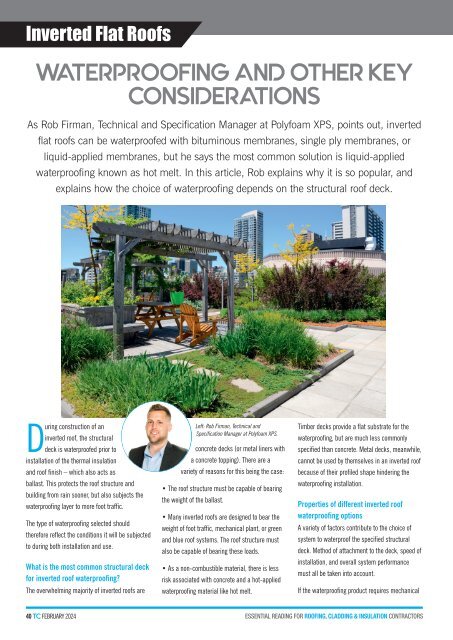February 2024
Create successful ePaper yourself
Turn your PDF publications into a flip-book with our unique Google optimized e-Paper software.
Inverted Flat Roofs<br />
WATERPROOFING AND OTHER KEY<br />
CONSIDERATIONS<br />
As Rob Firman, Technical and Specification Manager at Polyfoam XPS, points out, inverted<br />
flat roofs can be waterproofed with bituminous membranes, single ply membranes, or<br />
liquid-applied membranes, but he says the most common solution is liquid-applied<br />
waterproofing known as hot melt. In this article, Rob explains why it is so popular, and<br />
explains how the choice of waterproofing depends on the structural roof deck.<br />
During construction of an<br />
inverted roof, the structural<br />
deck is waterproofed prior to<br />
installation of the thermal insulation<br />
and roof finish – which also acts as<br />
ballast. This protects the roof structure and<br />
building from rain sooner, but also subjects the<br />
waterproofing layer to more foot traffic.<br />
The type of waterproofing selected should<br />
therefore reflect the conditions it will be subjected<br />
to during both installation and use.<br />
What is the most common structural deck<br />
for inverted roof waterproofing?<br />
The overwhelming majority of inverted roofs are<br />
Left: Rob Firman, Technical and<br />
Specification Manager at Polyfoam XPS.<br />
concrete decks (or metal liners with<br />
a concrete topping). There are a<br />
variety of reasons for this being the case:<br />
• The roof structure must be capable of bearing<br />
the weight of the ballast.<br />
• Many inverted roofs are designed to bear the<br />
weight of foot traffic, mechanical plant, or green<br />
and blue roof systems. The roof structure must<br />
also be capable of bearing these loads.<br />
• As a non-combustible material, there is less<br />
risk associated with concrete and a hot-applied<br />
waterproofing material like hot melt.<br />
Timber decks provide a flat substrate for the<br />
waterproofing, but are much less commonly<br />
specified than concrete. Metal decks, meanwhile,<br />
cannot be used by themselves in an inverted roof<br />
because of their profiled shape hindering the<br />
waterproofing installation.<br />
Properties of different inverted roof<br />
waterproofing options<br />
A variety of factors contribute to the choice of<br />
system to waterproof the specified structural<br />
deck. Method of attachment to the deck, speed of<br />
installation, and overall system performance<br />
must all be taken into account.<br />
If the waterproofing product requires mechanical<br />
40 TC FEBRUARY <strong>2024</strong>
















